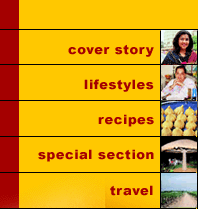


|
|
|
TAMARIND is a great favourite all over Andhra and is used extensively in numerous forms. Its fresh new flowers and tender leaves called Chigur are curried, and the fruit is used to make chutneys as well as cooling drinks. For this the variety of tamarind grown in Bangalore is preferred as it is light brown in colour and less sour. The most sought after is the rare Lal Imli or red tamarind. Its juice tastes wonderful with a dash of rock salt and sugar. It is also excellent for jams and jellies.
Apart from the tamarind, the other essential ingredient in Andhra cooking is the red chilli. Koraivikaram, the flaming stick, the very hottest red chilli, is grown in Guntur, and is used extensively in Andhra.
The Gongura, also known as ambada, is another very popular Andhra speciality. This is the leaf of the hiscus sabdariffa plant which grows well in Andhra. Its flowers are most attractive in a flower arrangement but can also be cooked and made into a jam. Gongura is cooked with meat or with chana dal and is also made into a pickle which can stay for over a year. It is often cooked with Seene ka Gosht in Hyderabad cuisine , the tender succulent meat around the breast of the sheep. I have tried, while abroad, to make a version of it using spinach and tamarind; it tasted good, but was never quite the same!
|

Home Page
About the mag
Subscribe
Advertise
Contact Us

 And The Gongura Is Another Speciality!
And The Gongura Is Another Speciality!
 The tamarind not only helps to digest the rich, hot, spicy Andhra food but is also considered cooling for the system as it helps to clear and empty the stomach. It is a mild and safe laxative taken as sherbet, especially during pregnancy. The beneficial uses of tamarind have been scientifically tested as well. It is considered a mild heart-tonic, if its seeds are soaked overnight and then peeled and eaten, they relieve pain in the lower back. Tamarind also helps to tempt one�s appetite in a Rasam (pepper water) or Pulihora Rice, particularly in summer when the hot weather makes heavy food undesirable. Tamarind seeds can even be ground into flour for making unleavened bread. Not only that, the ripe tamarind can be eaten as a sweet when mixed with jaggery.
The tamarind not only helps to digest the rich, hot, spicy Andhra food but is also considered cooling for the system as it helps to clear and empty the stomach. It is a mild and safe laxative taken as sherbet, especially during pregnancy. The beneficial uses of tamarind have been scientifically tested as well. It is considered a mild heart-tonic, if its seeds are soaked overnight and then peeled and eaten, they relieve pain in the lower back. Tamarind also helps to tempt one�s appetite in a Rasam (pepper water) or Pulihora Rice, particularly in summer when the hot weather makes heavy food undesirable. Tamarind seeds can even be ground into flour for making unleavened bread. Not only that, the ripe tamarind can be eaten as a sweet when mixed with jaggery. The cuisine of Guntur is amongst the �hottest� in terms of its chilli content. A chutney made from these freshly plucked red chillies, pounded fine and mixed with fresh brown tamarind pulp and salt, is a speciality of the area. This is preserved all year long and is eaten with freshly boiled rice and ghee. It is also delicious with milo bread and curd.
The cuisine of Guntur is amongst the �hottest� in terms of its chilli content. A chutney made from these freshly plucked red chillies, pounded fine and mixed with fresh brown tamarind pulp and salt, is a speciality of the area. This is preserved all year long and is eaten with freshly boiled rice and ghee. It is also delicious with milo bread and curd.